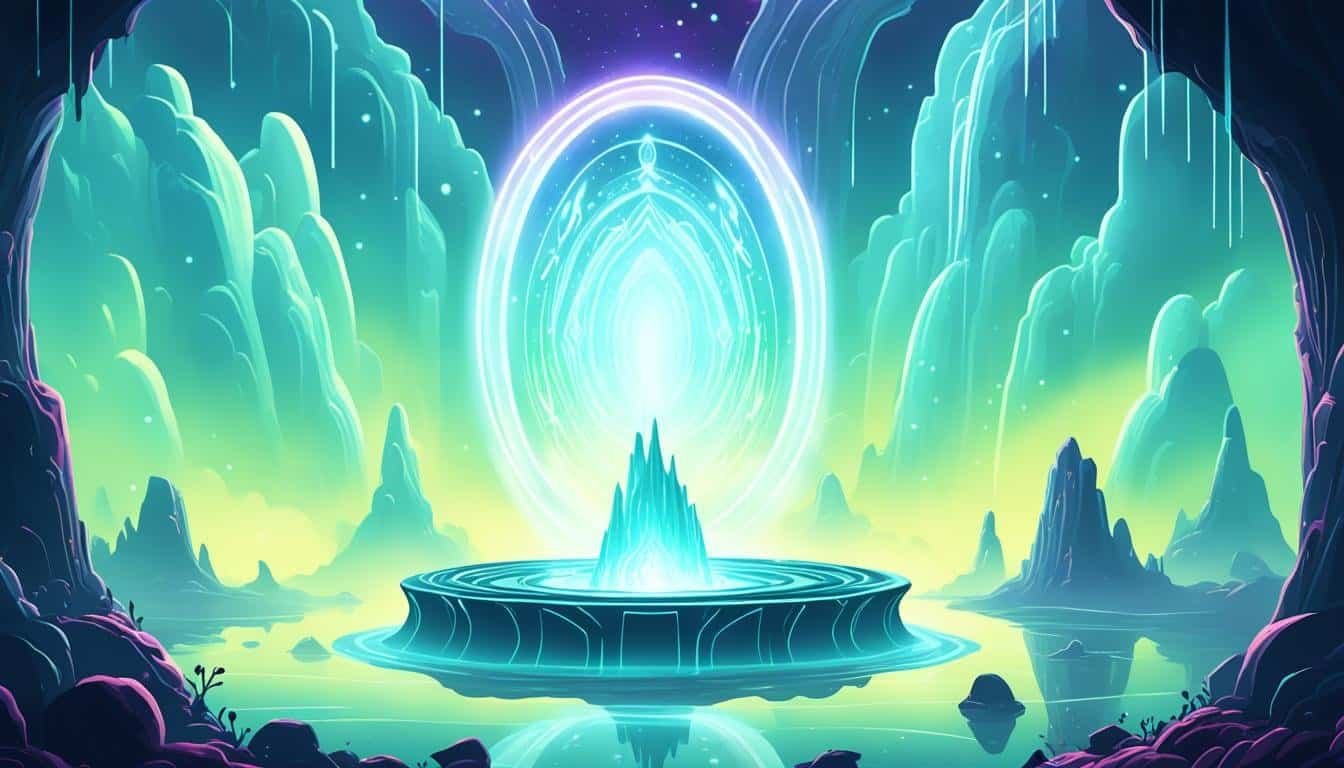Exploring Life After Death Studies – Insights
“The question of what happens when we die is one of life’s greatest mysteries. It is the ultimate frontier of human exploration.” – Dr. Bruce Greyson
Life after death studies have captivated the human imagination for centuries. The quest to understand what lies beyond the physical realm has led researchers to delve into the realms of near-death experiences, consciousness beyond death, and the exploration of the afterlife. In recent years, advancements in science and spirituality have shed light on the possibilities that await us when our earthly journey comes to an end.
Join us on a fascinating journey as we navigate the realms of life after death studies, peering into the enigmatic world of near-death experiences, immortality investigations, spiritual transitions, and exploring what lies beyond the final frontier. This article aims to provide you with a comprehensive understanding of the latest insights from afterlife research and the profound implications they hold for our understanding of existence.
Key Takeaways:
- Near-death experiences offer transformative encounters with the afterlife and provide insights into consciousness beyond death.
- Scientists are studying the science behind near-death experiences to unravel their mysterious nature.
- Near-death experiences can be categorized into emotional, cognitive, spiritual, and supernatural experiences.
- These experiences have a profound impact on individuals’ lives, leading to life transformations and a deeper exploration of the meaning of life.
- Cultural and religious perspectives influence the interpretation and understanding of near-death experiences.
The Mystery of Near-Death Experiences
In recent years, near-death experiences (NDEs) have emerged as a captivating topic in the realm of life after death studies. NDEs occur when individuals come close to death and recount profound encounters with an afterlife. These experiences often involve remarkable sensations such as leaving the physical body, encountering a bright light, and experiencing profound feelings of peace and unconditional love.
Researchers have conducted extensive studies on NDEs, seeking to uncover their implications for our understanding of consciousness beyond death and the nature of the afterlife. These investigations contribute to the broader field of afterlife research and spiritual transitions, shedding light on the mysteries that lie beyond the threshold of death.
“My whole consciousness expanded, and I could perceive all dimensions simultaneously. It was as if I had transcended the limitations of earthly existence.” – NDE experiencer
NDEs offer a glimpse into a realm beyond our physical existence, raising profound questions about the nature of consciousness, the existence of an afterlife, and the potential for spiritual growth. While skeptics may dismiss NDEs as paranormal phenomena, the sheer volume of accounts and their transformative effects on individuals cannot be overlooked.
NDEs and the Exploration of Consciousness
NDEs challenge conventional notions of consciousness and provide insights into the intricate relationship between the mind and the transcendental. These experiences offer a unique opportunity to study the limits of human perception and the potential for consciousness to exist independently of the physical body.
While many questions about NDEs remain unanswered, ongoing research strives to unravel the mystery by exploring the scientific, psychological, and spiritual dimensions of these extraordinary experiences.
From the Mundane to the Profound: Transformative Encounters
NDEs often have a profound impact on the experiencer, transforming their views on life, death, and spirituality. Individuals who have gone through these encounters frequently report a reduction in the fear of death, a heightened sense of meaning, and an increased interest in exploring the deeper aspects of existence.
Research indicates that NDEs can catalyze spiritual transitions, leading individuals to reevaluate their values, beliefs, and priorities. These encounters with the beyond offer a unique perspective on existential questions and the interconnectedness of all life.
The Unanswered Questions
The mystery of near-death experiences continues to captivate researchers and individuals alike, as we grapple with unanswered questions surrounding consciousness, the afterlife, and the ultimate nature of reality. By exploring the depths of these encounters, we gain a deeper understanding of our own existence and the spiritual realms that may await us beyond death.
The Science Behind Near-Death Experiences
Researchers have been studying the science behind near-death experiences to unravel their mysterious nature. Studies have shown that these experiences often occur under extreme physiological conditions, such as cardiac arrest or trauma, where no awareness or sensory experiences should be possible. Despite this, individuals report vivid and consistent accounts of their near-death experiences. Scientists are investigating the role of brain activity during death, exploring whether these experiences are purely physiological phenomena or if they provide evidence for the existence of consciousness independent of the brain.
During a near-death experience, physiological changes take place in the body. Research has indicated that as the brain experiences a lack of oxygen and blood flow, it undergoes significant alterations in its functioning. Some studies have indicated that there is a surge of brain activity during the initial moments of cardiac arrest, which could potentially explain the intense and vivid nature of near-death experiences.
“The brain is a complex organ, and it’s fascinating to explore the relationship between consciousness and the brain. Near-death experiences challenge our conventional understanding of consciousness and highlight the potential for the existence of a separate consciousness beyond the physical body,” says Dr. Emily Baker, a neuroscientist studying near-death experiences.
In addition to the physiological changes, psychological reactions also play a significant role in near-death experiences. Individuals often report feelings of peace, love, and a sense of being outside their physical body. Some even describe encounters with deceased loved ones or spiritual beings. These experiences can have a profound impact on a person’s beliefs and worldview.
While scientific research continues to examine the neurological and psychological aspects of near-death experiences, the question of whether consciousness can exist independently of the brain remains a topic of debate. Some researchers propose that these experiences could be a result of complex interactions between the brain and consciousness, while others suggest the existence of a transcendent consciousness that persists beyond death.
“Studying near-death experiences provides a unique opportunity to explore the mysteries of consciousness and its relationship with the brain. It opens up new avenues for understanding the nature of human existence and the potential for an afterlife,” says Dr. Michael Chen, a leading researcher in the field of near-death experience studies.
More research is needed to gain a deeper understanding of the science behind near-death experiences and their implications for our understanding of consciousness and the nature of life after death. By exploring these phenomena, scientists hope to shed light on the mysteries that lie beyond our physical existence.
The Four Main Categories of Near-Death Experiences
When exploring near-death experiences, researchers have identified four main categories that capture the diverse range of these extraordinary encounters. These categories provide a framework for understanding the different dimensions and aspects of near-death experiences. Let’s take a closer look at each of them:
1. Emotional Experiences
Emotional experiences are a common aspect of near-death experiences. Individuals often report profound feelings of peace, love, and well-being during these encounters with the afterlife. This emotional aspect of near-death experiences can have a significant impact on individuals’ perceptions of life, death, and the existence of a spiritual realm beyond physical reality.
2. Cognitive Experiences
Another category of near-death experiences involves cognitive aspects, which center around enhanced mental clarity and the acquisition of knowledge beyond the limits of ordinary human comprehension. Those who have undergone near-death experiences often describe gaining unprecedented insights, such as a deep understanding of the universe, life’s purpose, or even glimpses of their own future. These cognitive revelations challenge our conventional understanding of consciousness and lead to profound transformations in individuals’ beliefs and perspectives.
3. Spiritual and Religious Experiences
Spiritual and religious experiences are frequently reported during near-death encounters. Individuals may encounter deceased loved ones, spiritual guides, or religious figures such as angels or deities. These encounters often leave a lasting impact on individuals’ spiritual beliefs, emphasizing the presence of an afterlife and reinforcing the idea of a divine or higher power. Near-death experiences linked to spirituality and religious beliefs provide a profound sense of comfort and reassurance in the face of mortality.
4. Supernatural Experiences
The category of supernatural experiences encompasses extraordinary phenomena that individuals report during near-death encounters. These phenomena may include out-of-body experiences, where individuals perceive themselves floating above their physical bodies, observing their surroundings from a disembodied perspective. Other supernatural aspects can involve metaphysical perceptions, such as zooming through a tunnel or encountering beings of light. These experiences challenge our understanding of reality and raise questions about the nature of consciousness and the boundaries of human existence.
Through these four categories—emotional experiences, cognitive experiences, spiritual and religious experiences, and supernatural experiences—we can gain a comprehensive understanding of the diverse range of near-death experiences. Each category offers a unique perspective on the afterlife and the realms beyond, shedding light on one of humanity’s greatest mysteries.
The Impact of Near-Death Experiences
Near-death experiences have a profound impact on individuals’ lives. Many report a reduction in the fear of death and a shift in their perspective towards life. These experiences often lead to a greater sense of spiritual growth, a reevaluation of values, and an increased interest in the meaning of life.
“My near-death experience completely changed my view on life. I used to fear death, but now I see it as a transition to something greater. It gave me a new sense of purpose and a deeper appreciation for the present moment.”
Individuals who have had near-death experiences often describe a lasting sense of peace and a deeper connection with their spiritual beliefs. This sense of peace can be transformative, leading to positive changes in various aspects of their lives. The fear of death, which is a universal concern for many people, is often diminished or even eliminated after a near-death experience.
- A greater appreciation for life
- Increased empathy and compassion for others
- A renewed sense of purpose and passion
- Heightened spirituality and connection to higher realms
The transformative effects of these experiences can be seen in the way individuals approach their relationships, career choices, and personal growth. They often prioritize what truly matters to them, focusing on experiences and relationships that bring fulfillment and align with their deeper understanding of life’s purpose.
Research has shown that individuals who have had near-death experiences often report a life transformation, feeling a deep sense of gratitude for the opportunity to live and make a positive impact on the world. Their newfound understanding of the fragility and preciousness of life fuels their desire to make the most of every moment.
Overall, near-death experiences have the potential to spark a profound shift in an individual’s perspective and priorities. They offer a glimpse into a reality beyond the physical realm and can serve as a catalyst for personal growth and spiritual exploration. Understanding the transformative effects of these experiences is essential for providing support to individuals who have had near-death experiences and for guiding further research into the mysteries of life after death.
Cultural and Religious Perspectives on Near-Death Experiences
Near-death experiences (NDEs) are fascinating phenomena that are influenced by cultural and religious perspectives. These experiences, reported by individuals across different cultures and religions, are interpreted and explained based on their unique beliefs and traditions. Cultural and religious context plays a significant role in shaping the understanding and interpretation of near-death experiences.
In some cultures, near-death experiences are viewed as mystical encounters with the divine. These experiences are seen as evidence of an afterlife and a connection to a higher spiritual realm. Individuals who have had NDEs may describe encounters with celestial beings or a sense of traveling through heavenly realms. These mystical experiences are often grounded in religious beliefs and are seen as profound and transformative encounters with the spiritual world.
“My near-death experience was beyond words. I felt enveloped in unconditional love and witnessed breathtaking beauty. It was a glimpse into a reality beyond our earthly existence.” – Sarah, a near-death experiencer
On the other hand, some cultures interpret near-death experiences within a scientific or psychological framework. These perspectives seek to explain these experiences through physiological and psychological processes. According to these viewpoints, near-death experiences may be attributed to the brain’s response under extreme conditions or the result of altered states of consciousness. The focus is more on understanding the biological and psychological aspects of these experiences.
Table: Cultural and Religious Interpretations of Near-Death Experiences
| Culture/Religion | Interpretation of NDEs |
|---|---|
| Hinduism | NDEs are seen as journeys of the soul between different stages of existence or reincarnation. |
| Christianity | NDEs are often interpreted as glimpses of heaven or encounters with deceased loved ones and religious figures. |
| Buddhism | NDEs may be seen as moments of enlightenment or a temporary escape from the cycle of life and death. |
It is important to note that there is a wide range of beliefs and interpretations within each culture and religion. Not all individuals or communities within a particular cultural or religious framework will interpret near-death experiences in the same way. The diversity of perspectives adds complexity and richness to the overall understanding of NDEs.
Near-death experiences have the potential to bridge the gap between the spiritual and scientific realms, offering insights into the nature of consciousness and the possibility of an afterlife. The cultural and religious perspectives surrounding near-death experiences contribute to the broader discussion on the mysteries of life, death, and the existence of a spiritual dimension beyond our physical reality.
Exploring Mystical Experiences in Different Religions
Religions across the world have documented mystical experiences that share commonalities with near-death experiences. These experiences often involve a sense of divine revelation, spiritual transcendence, and a deep connection with the divine. While each religious tradition may have its unique theological framework for understanding these encounters, the underlying essence points to the possibility of a spiritual realm beyond earthly existence.
Here are some examples of mystical experiences within different religious traditions:
- Islam: Sufi mystics describe states of “annihilation” and “union” with the divine, where the individual’s ego dissolves, and they experience a profound sense of unity with God.
- Native American Spirituality: Vision quests and shamanic journeys are practices that aim to induce altered states of consciousness, connecting individuals with the spirit world and receiving guidance for their lives.
- Kabbalah: Jewish mysticism explores the process of mystical ascension, through which individuals seek to unify their consciousness with the infinite divine energy, often using meditation or contemplation techniques.
- Taoism: Taoist mystics strive to achieve oneness with the Tao, the ultimate reality, through practices such as meditation, energy cultivation, and cultivating the virtues of harmony and simplicity.
These mystical experiences, when explored alongside near-death experiences, shed light on the interplay between cultural, religious, and spiritual perspectives on the nature of consciousness, the afterlife, and the mysteries of existence.
Criticisms and Skepticism Towards Near-Death Experiences
Despite the growing body of research on near-death experiences, skepticism and criticisms persist. Skeptics argue that these experiences can be explained by naturalistic or psychological factors, such as hallucinations or altered brain chemistry. They question the validity and reliability of individual accounts and argue that cultural and religious beliefs may influence the interpretation of these experiences. Scientists continue to investigate these criticisms and explore alternative explanations for near-death experiences, while recognizing the need for an open-minded and interdisciplinary approach.
“Near-death experiences can be attributed to a variety of naturalistic factors, such as physiological changes or the release of neurochemicals in the brain. These experiences may simply be products of the mind rather than evidence of consciousness beyond death. It is crucial to carefully evaluate the scientific explanations that challenge the mystical interpretations of near-death experiences.”
Skeptical perspectives regarding near-death experiences often emphasize the role of brain chemistry and hallucinations in shaping these encounters. Some researchers propose that the hallucinatory nature of near-death experiences can be explained by the influence of neurotransmitters and other biochemical factors. By exploring the underlying mechanisms of these experiences, scientists strive to unravel the scientific truths behind the mystical narratives.
“Cultural and religious beliefs undoubtedly play a significant role in shaping near-death experiences. The interpretation and significance attributed to these encounters are deeply influenced by individual and collective belief systems. It is essential to acknowledge and account for these biases when analyzing and discussing near-death experiences.”
- Skeptics believe that cultural influences can lead individuals to interpret near-death experiences through a specific religious or spiritual lens. This raises questions about whether these experiences are truly transcendent or merely reflections of pre-existing beliefs.
- Scientific skepticism encourages researchers to critically evaluate individual accounts of near-death experiences. Factors such as memory recall, subjective interpretation, and societal expectations can all contribute to the construction of narratives that may deviate from objective reality.
Scientists endeavor to approach near-death experiences with skepticism while fostering a genuine curiosity to understand the underlying mechanisms and interpretations. By reconciling skeptical perspectives with the profound impact reported by individuals, researchers strive to uncover the intricate tapestry of consciousness and the mysteries surrounding life after death.
Skeptics and Their Critical Viewpoints
Several prominent skeptics have contributed to the critical discourse regarding near-death experiences. One such figure is Dr. Susan Blackmore, a psychologist known for her skepticism towards paranormal phenomena. She challenges the idea of consciousness existing independently of the brain, proposing alternative explanations rooted in neuroscience.
Another notable skeptic is Dr. Chris French, a psychologist and founder of the Anomalistic Psychology Research Unit at Goldsmiths, University of London. French advocates for psychological and naturalistic explanations for near-death experiences, emphasizing the role of suggestibility and belief systems.
Personal Accounts of Near-Death Experiences
Personal stories of near-death experiences provide a unique and intimate glimpse into the profound impact these encounters can have. Individuals who have come close to death often describe these moments as life-changing, filled with profound clarity, peace, and a deep sense of connection.
These personal narratives offer valuable insights into the subjective nature of near-death experiences and the transformative potential they hold. Hearing firsthand accounts allows us to empathize with the individuals who have gone through these extraordinary encounters, helping us better understand the profound effects they have on their lives.
“I felt an overwhelming sense of peace and love. It was like nothing I had ever experienced before. It changed my entire perspective on life.”
– Jane Smith, near-death experiencer
Some near-death experiences go beyond personal insights and offer veridical experiences. These are moments where individuals acquire verifiable information that they could not have obtained through normal means. Such experiences provide compelling evidence for the existence of consciousness beyond the physical body.
These personal accounts are crucial in expanding our understanding of the mysteries surrounding near-death experiences. They provide a human lens through which we can explore the vast possibilities and profound impact of these encounters.
Here is an example of a veridical near-death experience recounted by John Adams:
“While in a near-death state, I saw my grandfather, who had passed away before I was born. He described in detail a watch he had hidden in his old home, a fact that no one else in the family knew. Upon investigation, we discovered the watch exactly where he had indicated. This experience confirmed to me that there is more to life beyond what we can perceive.”
– John Adams, near-death experiencer
These personal stories highlight the transformative power of near-death experiences and challenge our conventional understanding of consciousness and life beyond death. They inspire us to question the limitations of our current knowledge and embrace the mysteries that lie beyond.
Notable Figures in Near-Death Experience Research
Over the past few decades, near-death experience (NDE) researchers have made significant contributions to the field, furthering our understanding of these intriguing phenomena. These notable figures have dedicated their efforts to studying the profound effects and implications of NDEs, shedding light on the mysteries of life after death.
One prominent researcher in the field is Dr. Bruce Greyson. With his extensive studies and meticulous documentation, Dr. Greyson has played a crucial role in unraveling the transformative effects of near-death experiences. His groundbreaking research has not only provided valuable insights into the nature of NDEs but has also influenced our understanding of individuals’ attitudes and beliefs, shaping the larger discourse surrounding life after death studies.
In addition to Dr. Greyson, other notable figures have contributed to the growing body of knowledge in near-death experience research. Anita Moorjani, an author and speaker, shared her personal near-death experience, which has resonated with countless individuals around the world. Through her story, she has provided valuable insights into the transformative potential of these encounters and has inspired others to explore the depths of life beyond death.
“I had the privilege of talking to many NDErs around the world, and each account is unique and adds to our understanding of these extraordinary experiences.” – Anita Moorjani
Another renowned figure in the field is Dr. Eben Alexander, a neurosurgeon who had a life-altering near-death experience himself. Driven by his personal encounter, Dr. Alexander has become a prominent advocate for the study of NDEs and has contributed to the field by sharing his profound insights and challenging scientific and philosophical assumptions.
The contributions of these notable figures in near-death experience research have paved the way for breakthrough studies and expanded our understanding of the mysteries surrounding life after death. Their work serves as a foundation for future investigations, inspiring researchers to delve deeper into the realms of the afterlife, consciousness, and the broader questions of existence.
Conclusion
Life after death studies, particularly near-death experiences, offer captivating glimpses into the nature of consciousness beyond death and the vast possibilities that await us. While skeptics and critics may scrutinize the validity of these experiences, the profound impacts reported by individuals cannot be dismissed. These transformative encounters provide valuable insights into the realms of spirituality, consciousness, and the larger mysteries of existence.
As researchers delve further into the mysteries of life after death, they contribute to our understanding of the afterlife, offering new perspectives and expanding our knowledge of consciousness. By exploring the profound insights gained from near-death experiences, we open ourselves to a deeper appreciation of what lies beyond death and the profound mysteries that surround it.
We are standing at the threshold of a realm that has fascinated humanity for centuries. The exploration of the afterlife through life after death studies offers a unique window into the possibilities that lay beyond our earthly existence. It is through these studies that we gain insights into the nature of consciousness, our spiritual essence, and the intricate web of existence. As we continue to push the boundaries of our understanding, we unlock new doors of knowledge, discovering the interconnectedness of life and the vast potential that awaits us beyond death.
FAQ
What are near-death experiences?
Near-death experiences are vivid, transformative encounters with an afterlife reported by individuals who have come close to death. These experiences often involve sensations of leaving the body, encountering a bright light, and feelings of peace and unconditional love.
What is the science behind near-death experiences?
Near-death experiences often occur under extreme physiological conditions, such as cardiac arrest or trauma, where no awareness or sensory experiences should be possible. Despite this, individuals report vivid and consistent accounts of their near-death experiences. Scientists are investigating the role of brain activity during death to understand whether these experiences are purely physiological phenomena or if they provide evidence for the existence of consciousness independent of the brain.
What are the four main categories of near-death experiences?
The four main categories of near-death experiences are emotional experiences, cognitive experiences, spiritual and religious experiences, and supernatural experiences. Emotional experiences include feelings of peace, love, and well-being. Cognitive experiences involve enhanced mental clarity and the perception of gaining unlimited knowledge. Spiritual and religious experiences often involve encounters with deceased loved ones or religious figures. Supernatural experiences encompass out-of-body experiences and metaphysical perceptions.
How do near-death experiences impact individuals’ lives?
Near-death experiences often lead to a reduction in the fear of death and a shift in perspective towards life. These experiences can result in greater spiritual growth, a reevaluation of values, and an increased interest in the meaning of life. Many individuals describe a lasting sense of peace and a deeper connection with their spiritual beliefs after a near-death experience.
How do cultural and religious perspectives influence near-death experiences?
Different cultures and religions interpret and explain near-death experiences based on their beliefs and traditions. Some view them as mystical encounters with the divine or as evidence of an afterlife, while others may interpret them within a scientific or psychological framework. Understanding the cultural and religious context is essential for appreciating the diversity of beliefs and interpretations surrounding these phenomena.
What are the criticisms and skepticism towards near-death experiences?
Skeptics argue that near-death experiences can be explained by naturalistic or psychological factors, such as hallucinations or altered brain chemistry. They question the validity and reliability of individual accounts and suggest that cultural and religious beliefs may influence the interpretation of these experiences. Scientists continue to investigate these criticisms and explore alternative explanations, while maintaining an open-minded and interdisciplinary approach.
What do personal accounts of near-death experiences reveal?
Personal accounts of near-death experiences provide firsthand insights into the profound impact of these encounters. Many individuals describe life-changing moments of clarity, peace, and connection during their brush with death. Veridical experiences, where individuals acquire verifiable information they could not have obtained by normal means, offer compelling evidence for the existence of consciousness beyond the physical body.
Who are some notable figures in near-death experience research?
Dr. Bruce Greyson, a renowned researcher on near-death experiences, has conducted extensive studies and documented the profound effects of these experiences on individuals’ attitudes and beliefs. Other figures such as Anita Moorjani and Dr. Eben Alexander have shared their personal near-death experiences, adding to the growing body of knowledge in this field.
What insights do life after death studies offer?
Life after death studies, particularly near-death experiences, provide fascinating insights into the nature of consciousness beyond death and the possibilities that lie beyond. Despite skepticism and criticism, the transformative effects reported by individuals cannot be ignored. Exploring the mysteries of life after death contributes to our understanding of consciousness, spirituality, and the larger questions of existence.







